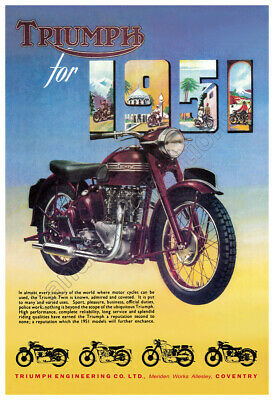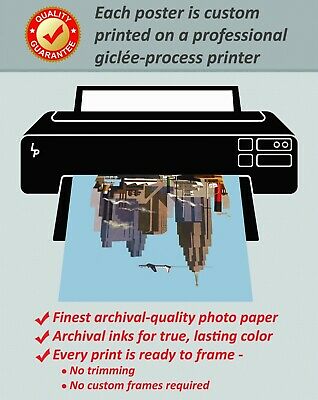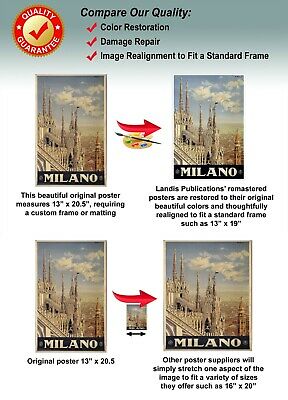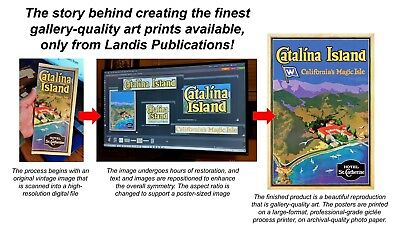-40%
1951 Triumph Motorcycle - Vintage Advertising Poster
$ 10.53
- Description
- Size Guide
Description
These are simply the best posters available! You will be thrilled with the image quality, vivid colors, fine paper, and unique subjects.
OUR POSTERS ARE SIZED FOR STANDARD OFF-THE-SHELF FRAMES, WITH NO CUSTOM FRAMING REQUIRED, PROVIDING HUGE COST SAVINGS!
This beautiful reproduction poster has been re-mastered from an original Triumph Motorcycle advertisement from 1951.
The vibrant colors and detail of this classic image have been painstakingly brought back to life to preserve a great piece of history.
The high-resolution image is printed on heavy archival photo paper, on a large-format, professional giclée process printer. The poster is shipped in a rigid cardboard tube, and is ready for framing.
The 13"x19" format is an excellent image size that looks great as a stand-alone piece of art, or as a grouped visual statement. These posters require
no cutting, trimming, or custom framing
, and a wide variety of 13"x19" frames are readily available at your local craft or hobby retailer, and online.
A great vintage print for your home, shop, or business!
HISTORY OF TRIUMPH MOTORCYCLES
Triumph Engineering Co Ltd. (not to be confused with Triumph Motorcycles Ltd.) was a British motorcycle manufacturing company, based originally in Coventry and then in Solihull at Meriden. A new company, Triumph Motorcycles Ltd based in Hinckley gained the name rights after the end of the company in the 1980s and is now one of the world's major motorcycle manufacturers.
Origins
Model H, the "Trusty Triumph". 57,000 were made between 1915 and 1923
The company was started by Siegfried Bettmann, who had emigrated from Nuremberg, part of the German Empire, to Coventry in England in 1893. In 1884, aged 20, Bettmann had founded his own company, the S. Bettmann & Co. Import Export Agency, in London. Bettmann's original products were bicycles, which the company bought and then sold under its own name. Bettmann also distributed sewing machines imported from Germany.
In 1886, Bettmann sought a more specific name, and the company became known as the Triumph Cycle Company. A year later, the company was registered as the New Triumph Co. Ltd, now with funding from the Dunlop Pneumatic Tyre Company. During that year, another native of Nuremberg, Moritz Schulte, joined the company as a partner.
Schulte encouraged Bettmann to transform Triumph into a manufacturing company, and in 1888 Bettmann purchased a site in Coventry using money lent by his and Schulte's families. The company began producing the first Triumph-branded bicycles in 1889. In 1896 Triumph also opened a bicycle factory in Nuremberg.
In 1898 Triumph decided to extend production at Coventry to include motorcycles, and by 1902 the company had produced its first motorcycle — a bicycle fitted with a Belgian Minerva engine. In 1903, after selling more than 500 motorcycles, Triumph began motorcycle production at the Nuremberg factory. During the first few years the company based its designs on those of other manufacturers, but in 1904 Triumph began building motorcycles based on its own designs, and 1905 saw the first entirely in-house designed motorcycle. By the end of that year, the company had produced more than 250.
In 1907, after the company opened a larger plant, it produced 1,000 machines. Triumph had also initiated a lower-end brand, Gloria, also manufactured in the company's original plant.
Confusion between motorcycles produced by the Coventry and Nuremberg Triumph companies resulted in the latter's products being renamed Orial for certain export markets. However, a company named Orial already existed in France, so the Nuremberg motorcycles were renamed again as "TWN", standing for Triumph Werke Nürnberg.
Post-war era
The Triumph Speed Twin designed by Edward Turner before the war was produced in large numbers after the war. Efforts to settle the lend-lease debts caused nearly 70% of Triumph's post war production to be shipped to the United States. Post War, the Speed Twin and Triumph Tiger 100 were available with a sprung rear hub, Triumph's first attempt at a rear suspension.
Privateers put wartime surplus alloy barrels on their Tiger 100 racers, and won races, inspiring the Triumph GP model. By 1950 the supply of barrels was exhausted, and the GP model was ended. The American market applied considerable demand to reverse this action, and a die cast close finned alloy barrel was made available. The alloy head made the valve noise more obvious, so ramp type cams were introduced for alloy head models to reduce the noise.
Another motorcycle based on the wartime generator engine was the 498 cc TR5 Trophy Twin, also introduced at the 1948 Motor Cycle Show. It used a single carburettor, low compression version of the Grand Prix engine. Britain won the prestigious 1948 International Six Days Trial. The Triumph works team had finished unpenalised. One team member, Allan Jefferies, had been riding what amounted to a prototype version.
To satisfy the American demand for motorcycles suited to long distance riding, Turner built a 650 cc version of the Speed Twin design. The new bike was named the Thunderbird (a name Triumph would later license to the Ford Motor Company for use for a car model). Only one year after the Thunderbird was introduced, a motorcyclist in Southern California mated the 650 Thunderbird with a twin carb head intended originally for GP racing and named the new creation the Wonderbird. That 650 cc motor, designed in 1939, had the world's absolute speed record for motorcycles from 1955 until 1970.
The Triumph brand received considerable publicity in the United States when Marlon Brando rode a 1950 Thunderbird 6T in the 1953 film, The Wild One.
The Triumph Motorcycle concern was sold to their rivals BSA by Sangster in 1951. This sale included Sangster becoming a member of the BSA board. Sangster was to become Chairman of the BSA Group in 1956.
The production 650 cc Thunderbird (6T) was a low-compression tourer, and the 500 cc Tiger 100 was the performance motorcycle. That changed in 1954, with the change to swing arm frames, and the release of the alloy head 650 cc Tiger 110, eclipsing the 500 cc Tiger 100 as the performance model.
In 1959, the T120, a tuned double carburettor version of the Triumph Tiger T110, came to be known as the Bonneville. As Triumph and other marques gained market share, Harley became aware that their 1 litre-plus motorcycles were not as sporty as modern riders would like, resulting in a decreasing share of the market. The Triumphs were models for a new, "small" Harley-Davidson as a result: the now-fabled Harley-Davidson Sportster, which started as Harley's version of a Triumph Bonneville. With its anachronistic V-twin, the Sportster was no match for the Bonneville, but it proved a solid competitor in US sales and eventually also in longevity.
During the 1960s, despite internal opposition from those who believed that it would reduce the macho image of the brand, Triumph produced two scooters; the Triumph Tina, a small and low-performance 2-stroke scooter of about 100 cc with automatic clutch and a handlebar carry basket, and the Triumph Tigress, a more powerful scooter available with either a 175 cc 2-stroke single or a 250 cc 4-stroke twin engine for the enthusiast.
In 1962, the last year of the "pre-unit" models, Triumph used a frame with twin front down-tubes, but returned to a traditional Triumph single front downtube for the unit construction models that ensued. The twin down tube, or duplex frame, was used for the 650 twins, as a result of frame fractures on the Bonneville. Introduced in 1959, for the 1960 model year, it soon needed strengthening, and was ended in 1962, with the advent of the unit engines for the 650 range. The 3TA (21) was the first unit construction twin, soon followed by the short-stroke, 490 cc "500" range.
From 1963 all Triumph engines were of unit construction.
In 1969 Malcolm Uphill, riding a Bonneville, won the Isle of Man Production TT race with a race average of 99.99 miles per hour (160.92 km/h) per lap, and recorded the first ever more than 100 miles per hour (161 km/h) lap by a production motorcycle at 100.37 miles per hour (161.53 km/h). For many Triumph fans, the 1969 Bonneville was the best Triumph model ever.
American sales had already maximized, in 1967. In truth, the demand for motorcycles was increasing, but Triumph could not supply the demand.
During the 1960s, 60% of all Triumph production was exported, which, along with the BSA's 80% exports, made the group susceptible to the Japanese expansion. By 1969 fully 50% of the US market for motorcycles more than 500 cc belonged to Triumph, but technological advances at Triumph had failed to match those of the foreign companies. Triumphs lacked electric start mechanisms, relied on push-rods rather than overhead cams, vibrated noticeably, often leaked oil and had antiquated electrical systems; while Japanese marques such as Honda were building more advanced features into attractive new motorcycles that sold for less than their British competitors. Triumph motorcycles, as a result, were nearly obsolete even when they were new. Further, Triumph's manufacturing processes were very labor-intensive and largely inefficient. Also disastrous, during the early 1970s, the US government mandated that all motorcycle imports must have their gearshift and brake pedals in the Japanese configuration, which required expensive retooling of all the motorcycles for US sale.
Triumph and BSA were well aware of Honda's ability but while the Japanese were only making smaller engined models, the large engine market was considered safe. When the first Honda 750 cc four cylinder was released for sale to the public, Triumph and BSA had trouble. Despite developing and releasing a 3-cylinder 750 cc engined motorcycle prior to the Japanese fours: the BSA Rocket 3/Triumph Trident, the Japanese bikes were praised in the press for their modernity (disc brakes, 4-cylinder engines, leak-free engine casings, etc.). The British triples outperformed the Japanese fours (top speed, acceleration and handling) but the Japanese fours required less maintenance and they did not leak.
The 1970 Tiger/Bonneville re-design and taller twin front downtube oil tank frame had a mixed reception from Triumph enthusiasts at the time, and was insufficient to win back those already riding the Japanese bikes that had been vended since 1969; the Honda 750 Four, and the Kawasaki 500 Mach 3. The Triumph 350 cc Bandit received pre-publicity, but its development was quietly brought to an end. Triumph was still making motorcycles, but they no longer looked like the motorcycles Triumph fans expected. The Trident attracted its own market, but the Japanese motorcycles were improving more rapidly.
The parent BSA group had losses of £8.5 million in 1971, £3 million for BSA motorcycles alone. The British government became involved. The company was sold to Manganese Bronze Holdings, which also owned Norton, AJS, Matchless, Francis-Barnett, James-Velocette and Villiers.













